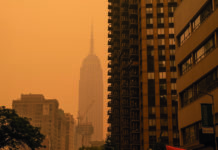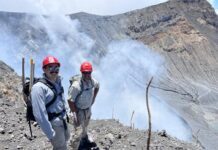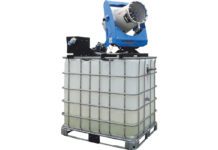More nuisance than health risk, in traditional thinking, but no longer. Dust has been driven up the safety agenda in recent years, not just in construction. Envirotec reviews recent thinking on the topic
Dust is everywhere, and covers a diverse range of particles, varying in size from less than 0.1μm to more than 2mm in diameter. And all kinds of substances make up what we consider ‘dust’, from pollen and human hair to the kinds of materials that might arise in the workplace from the action of abrasive machinery and activities like cutting, sanding, drilling or demolition.
The HsE’s ‘Dust Hub’ web page provides specific guidance on asbestos, flour, grain, silica and wood. While it’s tempting to think of dust as an occupational hazard of the past, given the decline in industries like mining, and the improvements in workplace conditions in many sectors, it continues to be a problem, with new growth areas and sources appearing all the time.
Occupational Lung Disease (OLD) appears to have risen sharply up the agenda of safety professionals in recent years, with a possible tipping point being the HsE’s recent listing of ‘lung health’ as one of its priorities for targeted improvement, in which it has received a star billing. And with good reason: Occupational respiratory disease is estimated to result in approximately 12,000 deaths per year, in addition to the 36,000 workers who reported work-related lung or breathing problems in a 2013/14-2015/16 Labour Force Survey.
The HsE has also previously pledged to “develop a strategic programme of research on occupational lung disease to help us better understand the underlying issues and how best to address them,” by Summer 2018, although Envirotec was unable to locate further detail on this at the time of writing.
A key reason for dust’s emergence as a topic of the moment is surely the growing base of evidence and documentation surrounding the health risks. Occupational health monitoring seems to have widened its focus beyond obvious danger dusts like lead and asbestos, and to have matured to offer greater perspective on other dusts.
Another reason for its greater visibility is likely to be spells of warm, dry weather last year – at times like these, airborne dusts from demolition or materials recycling plants tend to be more visible to the public. This also means members of the general public are just as likely to be complainants.
The HsE’s online documentation about OLD includes sector-specific pages about certain key sectors: stone work, quarries, metal work, wood work, construction, and bakeries. In some sectors the problem is getting worse, according to a TUC report, and in relatively new industries like recycling, workers risk exposure to a wide range of dusts. In some sectors such as manufacturing and warehousing, there is growing concern about the use of MDF, and associated dust.
Employer obligations
In UK law, employers have a duty to ensure that their activities do not endanger employees or the general public. A number of regulations have a bearing on dust, the principal set being the Control of Substances Hazardous to Health Regulations (COSHH). It classifies dust as a hazard to health when it is present at certain threshold concentrations, specific to the type of dust, averaged over an eight-hour period, or a working day. If any worker is at risk of exposure above these levels, employers are required to act.
There is also a hierarchy of priorities to be followed in this respect, with employers required to research alternative processes and less hazardous materials, as a primary measure, with remedial measures such as the fitting of ventilation systems following on from this. The use of protective equipment should be a last resort.
Other regulations relate to dust. The UK regulatory regime assigns Workplace Exposure Limits (WELs), specifying limits of exposure that shouldn’t be exceeded. Hundreds of substances have received a WEL, including a number of dusts.
A complicating factor when interpreting or applying such metrics is the fact that some dusts can be a mixture of many different substances, some of which might have a specified exposure limit or a WEL.
Silica contention
One recent focus of concern has been silica dust, a common hazard in construction – where it forms a key component of cement. Silica is now recognised in itself as a carcinogen. Commenting recently in The Guardian, Professor Anthony Newman Taylor of Imperial College’s National Heart and Lung Institute said that, since there appears to be enough evidence to establish that it is carcinogenic then “there can be no threshold [for safe exposure].”
So far, the only place where it has been officially classified as a carcinogen is Germany. But many other countries appear to impose stricter limits than the UK, where the legal limit for silica exposure in the UK is currently 0.1mg/m3, averaged over an eight-hour shift period. In the US, the legal limit was recently halved to 0.05mg/m3, following lobbying from its own equivalent to the HsE – the Occupational Safety and Health Administration. Even lower limits are specified in some regions, including British Columba, where the limit is 0.025mg/m3.
In mid-2018 the HsE was urging employers to review their health surveillance programs for workers at risk of developing lung disease. It recommended that workers at risk of exposure to silica should regularly undergo both x-ray screening and lung function tests – traditionally it has been one or the other.
The HsE provides documentation on how to control and prevent employee’s exposure to silica dust, with sector-specific sections for areas like construction, manufacturing, ceramics and so on.
Surveillance and protection
UK law also requires employers to carry out health surveillance, in situations where workers are exposed to a dust type associated with disease. An employer will normally establish whether or not such a surveillance program is required by completing a risk assessment, whereby workplace hazards are identified, as well as who is at risk.
Remedial measures to tackle dust in the workplace take a variety of forms. Equipment hire firm Envirogard – which operates throughout the UK – offers products that range from vacuum cleaners, to high efficiency air filtration units, and water misting cannons – for the suppression of airborne fugitive dusts.
The firm says it has seen a noticeable uptick in enquiries for dust suppression equipment recently. The impression is that dust may have been tolerated historically, but that no longer appears to be an option. The direction of travel seems to be that yesterday’s nuisance is tomorrow’s litigation headache.







